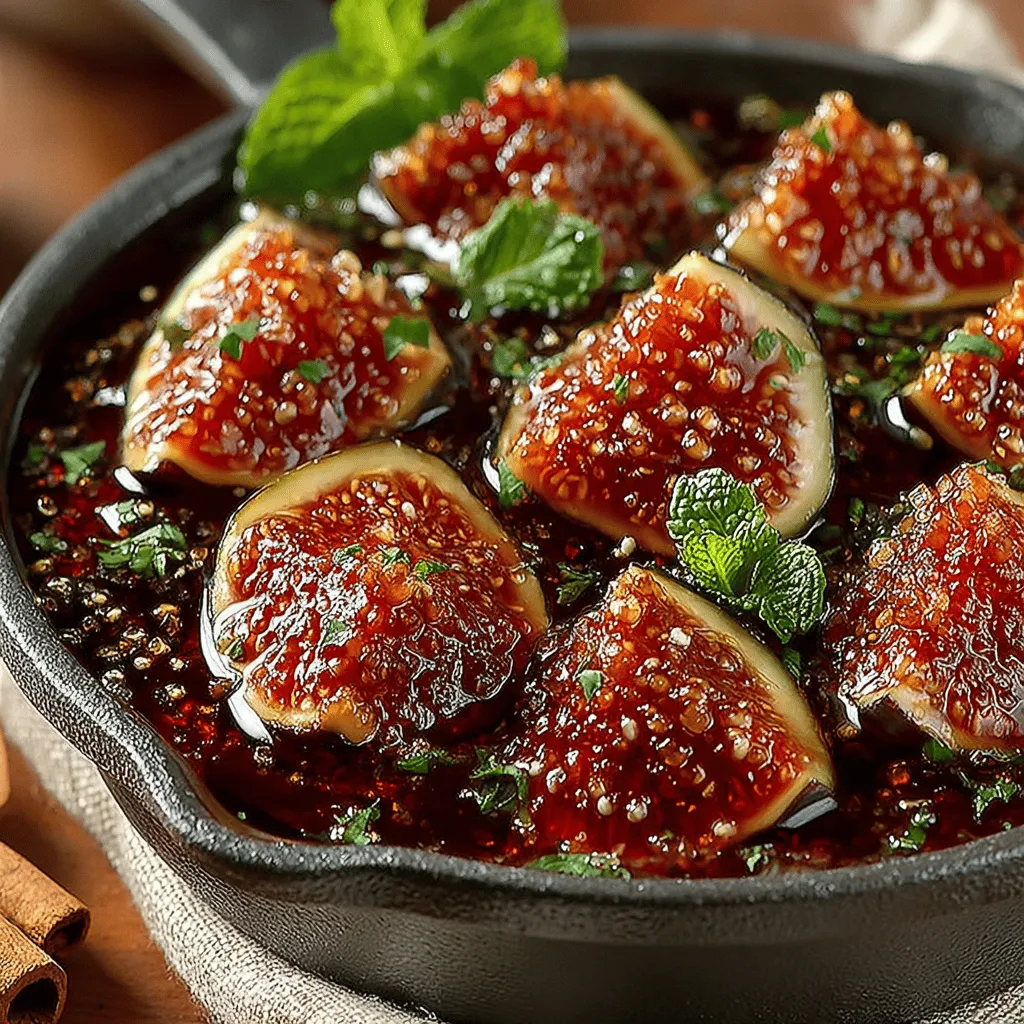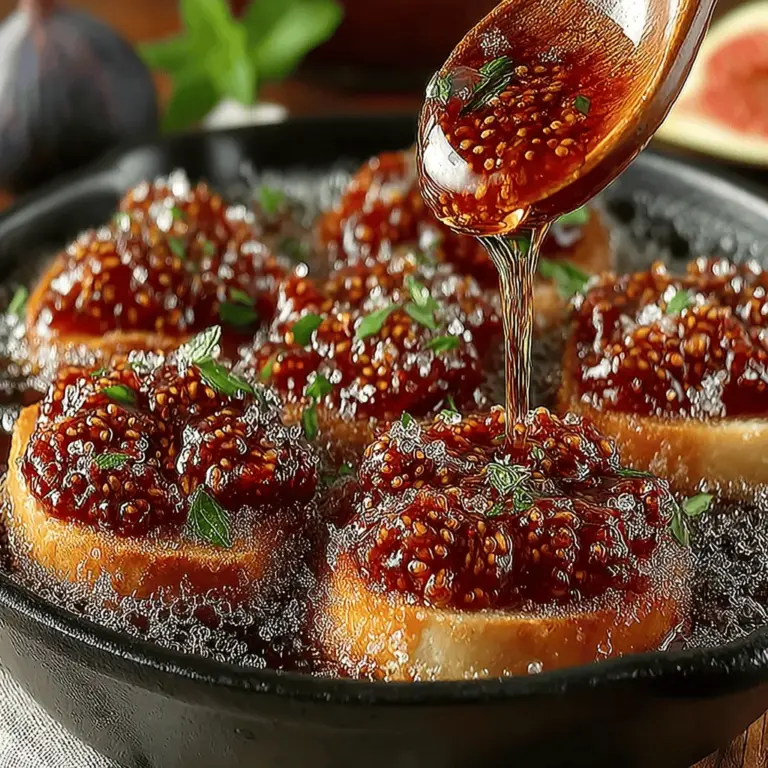In the world of preserves, few things evoke the warmth and nostalgia of homemade fig jam. This Heavenly Fig Jam Delight recipe captures the essence of ripe figs, transforming them into a luscious spread that is perfect for any occasion. Whether you’re spreading it on warm toast, using it as a dessert filling, or pairing it with cheese, this jam is a delightful addition to your culinary repertoire. The process of making fig jam is not just about preserving fruit; it’s a labor of love that connects you to the seasons and the joy of homemade goodness.
Understanding the Ingredients: What Makes This Fig Jam Special
To create a truly exceptional fig jam, understanding the core ingredients is essential. Each component contributes to the flavor profile and texture, ensuring that the final product is nothing short of heavenly.
Fresh Figs: The Star of the Show
At the heart of this recipe are fresh figs, which are not only delicious but also packed with nutrients. Figs are rich in dietary fiber, vitamins such as B6 and K, and minerals like magnesium and potassium. Their natural sweetness and unique texture make them an ideal base for jam. When selecting figs, look for ones that are plump, slightly soft, and fragrant, as these qualities indicate ripeness and optimal flavor.
Granulated Sugar: The Sweet Balance
Sugar plays a crucial role in the preservation process, helping to balance the natural sweetness of the figs while also enhancing their flavor. It acts as a preservative, drawing moisture out of the fruit and creating a syrupy consistency. The amount of sugar can be adjusted based on your personal taste preferences, but a standard ratio will ensure the perfect balance between sweetness and acidity.
Lemon Juice: Enhancing Flavor and Preserving Freshness
Lemon juice is a key ingredient in fig jam, serving two primary purposes. First, it adds a bright acidity that complements the sweetness of the figs, enhancing the overall flavor profile. Second, the acidity helps to preserve the jam, ensuring it remains fresh for an extended period. When using lemon juice, opt for freshly squeezed juice to achieve the best flavor.
Vanilla Extract: Adding Depth to the Sweetness
A splash of vanilla extract elevates the flavor of fig jam, adding a warm, aromatic note that pairs beautifully with the rich taste of figs. While optional, this ingredient can transform your jam from ordinary to extraordinary. Choose high-quality pure vanilla extract for the best results.
Ground Cinnamon: Optional Warmth and Spice
Ground cinnamon is another optional ingredient that can add a delightful warmth and complexity to your fig jam. Its warm, sweet-spicy aroma complements the natural flavors of the figs, making it a popular choice among jam enthusiasts. If you’re a fan of spices, a dash of cinnamon can take your fig jam to the next level.
Water: Creating the Perfect Cooking Environment
Water is essential for creating the right cooking environment. It helps to dissolve the sugar and allows the figs to soften as they cook. The amount of water used will depend on the juiciness of the figs, but typically, a small amount is sufficient to start the cooking process.
Fruit Pectin: Optional Thickening Agent
If you prefer a thicker consistency for your fig jam, you may consider using fruit pectin. This natural thickening agent is derived from fruits and can help achieve the desired texture without altering the flavor. However, many home cooks opt to let the natural pectin in the figs do the work, resulting in a more rustic jam.
Step-by-Step Guide to Making Heavenly Fig Jam
Now that we’ve explored the ingredients, let’s dive into the step-by-step process of creating your Heavenly Fig Jam.
Preparing the Figs: The First Step to a Perfect Jam
The first step in making fig jam is preparing the figs. Start by washing them gently under cool running water to remove any dirt or debris. Fresh figs are delicate, so handle them with care to avoid bruising.
Once washed, you’ll need to quarter the figs. This not only makes them easier to cook down but also helps to release their natural juices. The quartering process will depend on the size of the figs; larger figs may require cutting into eighths.
It’s essential to use figs that are at their peak ripeness. Overripe figs can result in a jam that is too mushy, while underripe figs may lack the depth of flavor you desire. When selecting figs, always opt for those that are firm yet slightly yielding to the touch, with no signs of mold or excessive blemishes.
Cooking the Mixture: Combining Flavors
Once your figs are prepped, it’s time to combine them with the other ingredients in a large, heavy-bottomed pot. Begin by adding your quartered figs, granulated sugar, lemon juice, and a splash of water. If you’re using vanilla extract and ground cinnamon, now is the time to add those as well.
As you cook the mixture over medium heat, stir gently to incorporate the sugar and prevent sticking. You’ll notice the figs begin to break down and release their juices, creating a beautiful syrup. The cooking process allows the flavors to meld, so it’s important to monitor the consistency as it cooks.
Achieving the right balance of sweetness and acidity is crucial. As the mixture bubbles and thickens, taste periodically to ensure the flavors are to your liking. If you find it too sweet, a little extra lemon juice can help brighten the flavor profile.
The cooking time can vary, but typically, it will take about 30 to 45 minutes for the mixture to reach the desired consistency. If you prefer a thicker jam, you can continue cooking it for a few extra minutes, stirring frequently to prevent burning.
With careful preparation and attention to detail, your Heavenly Fig Jam will soon be ready to be jarred and enjoyed. The next steps involve preserving your jam for long-lasting enjoyment, so stay tuned for the continuation of this delightful recipe.

Simmering the Jam: The Magic of Heat
As you embark on the journey of creating your Heavenly Fig Jam, the simmering stage is where the magic truly happens. This process transforms fresh figs into a luscious, sweet spread that can elevate your culinary creations.
Understanding the Cooking Process and the Transformation of Figs
When figs are cooked, their natural sugars intensify, and their flavors meld together, producing a rich and complex taste. The heat causes the figs to break down, releasing their juices and creating a syrupy mixture. This transformation is crucial in achieving that perfect jam texture, where the fruit remains partially intact with a smooth consistency.
Importance of Stirring and Monitoring Heat
During the simmering process, it is vital to stir the jam frequently. This action ensures that the fruit does not stick to the bottom of the pot, which can lead to burning and an unpleasant taste. Additionally, maintaining a low to medium heat helps control the cooking process, allowing the figs to soften gradually without becoming mushy. The goal is to simmer the jam slowly, giving the flavors time to develop while preventing the mixture from boiling over.
Checking for Consistency: Getting It Just Right
Once your fig jam has been simmering for a while, it’s time to check its consistency. Here are some techniques to ensure your jam reaches the perfect thickness.
Techniques for Testing Jam Consistency
1. Plate Test: Place a small plate in the freezer for about 10 minutes. Once chilled, drop a teaspoon of the jam onto the plate. Allow it to sit for a moment, then run your finger through the jam. If it holds its shape and doesn’t run back together, it’s ready for canning.
2. Spoon Test: Dip a cold spoon into the jam and lift it out. Observe how the jam drips off the spoon. If it falls in a thick ribbon rather than a steady stream, you’re on the right track.
3. Viscosity Check: The jam should coat the back of a spoon evenly. If it drips off too easily, it may need more cooking time.
The Role of Fruit Pectin and When to Add It
Figs naturally contain pectin, which helps in thickening the jam. However, if you prefer a thicker consistency or are using less ripe figs, you might consider adding commercial fruit pectin. Follow the manufacturer’s instructions for the correct timing and amount. Generally, you want to add pectin during the last few minutes of cooking to ensure it activates properly without overpowering the fresh fig flavor.
Canning and Storing: Preserving Your Creation
Once you’ve achieved that perfect jam consistency, it’s time to preserve your creation properly.
Guidelines for Safe Canning Practices
1. Sterilize Your Jars: Before filling your jars with fig jam, ensure they are clean and sterilized. You can do this by placing them in a boiling water bath for 10 minutes or running them through a dishwasher cycle on high heat.
2. Seal Properly: Fill the jars with hot jam, leaving about 1/4 inch of headspace. Wipe the rims of the jars with a clean, damp cloth to remove any residue before placing the lids on. Ensure the lids are tightly sealed to prevent any air from entering.
3. Water Bath Canning: After sealing your jars, process them in a boiling water bath for about 10-15 minutes. This step ensures that any bacteria are eliminated and helps create a vacuum seal.
Best Practices for Storing Fig Jam
Once your fig jam is properly canned, store it in a cool, dark place. A pantry or cupboard away from direct sunlight is ideal. If you’ve opened a jar of fig jam, keep it in the refrigerator and consume it within a few weeks. Properly sealed jars can last up to a year in storage, allowing you to enjoy the fruits of your labor long after fig season has passed.
The Versatility of Fig Jam: Culinary Uses and Serving Suggestions
Fig jam is not only delicious on its own but also incredibly versatile in the kitchen. It can be used in various ways to enhance your meals and snacks.
Spreading the Joy: Enjoying Your Fig Jam
1. Classic Pairings: Spread your fig jam on warm, toasted bread or buttery croissants for a delightful breakfast treat. It also pairs beautifully with scones and biscuits, making it a perfect addition to your afternoon tea.
2. Pastries and Desserts: Use fig jam as a filling for pastries, tarts, and cakes. Its sweet and fruity flavor complements a variety of desserts, adding a gourmet touch to your creations.
3. Accompaniments for Cheese Boards and Meats: Fig jam is a classic addition to cheese boards. Serve it alongside creamy cheeses like goat cheese or Brie for a delightful contrast. It also pairs well with cured meats, such as prosciutto or salami, making it a fantastic component of a charcuterie board.
Unique Uses: Beyond the Jar
– Salad Dressings: Incorporate fig jam into vinaigrettes for a sweet twist on traditional dressings. Combine it with balsamic vinegar and olive oil for a delicious salad topper.
– Glazes and Sauces: Use fig jam as a glaze for roasted meats, such as pork or chicken. It caramelizes beautifully, adding depth of flavor to your dishes. You can also mix it with barbecue sauce for a sweet and tangy twist.
Nutritional Benefits of Figs: Why You’ll Love This Jam Even More
Figs are not just a treat for the taste buds; they also offer numerous health benefits, making your homemade fig jam a guilt-free indulgence.
Overview of the Health Benefits of Figs
Figs are rich in dietary fiber, which supports digestive health and can help regulate blood sugar levels. They are also packed with essential vitamins and minerals, including vitamin B6, potassium, magnesium, and iron. These nutrients contribute to overall well-being, making figs a smart addition to your diet.
Nutritional Profile of Fig Jam
While fig jam does contain sugar, it also retains many of the nutritional benefits of fresh figs. A typical serving (one tablespoon) of fig jam contains approximately:
– Calories: 40
– Total Fat: 0g
– Sodium: 1mg
– Total Carbohydrates: 10g
– Dietary Fiber: 0.5g
– Sugars: 8g
– Protein: 0g
Moderation is key, but enjoying fig jam allows you to benefit from the goodness of figs while indulging in a delightful treat.
Conclusion: Embrace the Sweetness of Homemade Fig Jam
Creating your own Heavenly Fig Jam is not just about satisfying your taste buds; it’s about embracing the art of preserving and enjoying the fruits of the season. With its simple ingredients and easy steps, this recipe empowers you to craft something truly special. As you savor each spoonful, remember the joy of making it from scratch and the delightful experiences it can bring to your table. The versatility of fig jam allows it to shine in various dishes, making it a staple in your kitchen. So go ahead, spread the sweetness and enjoy the many ways to indulge in your homemade fig jam!

